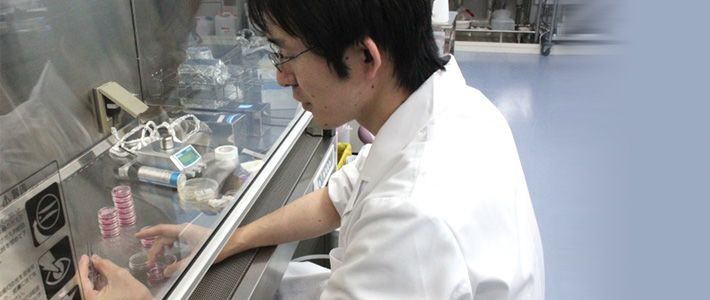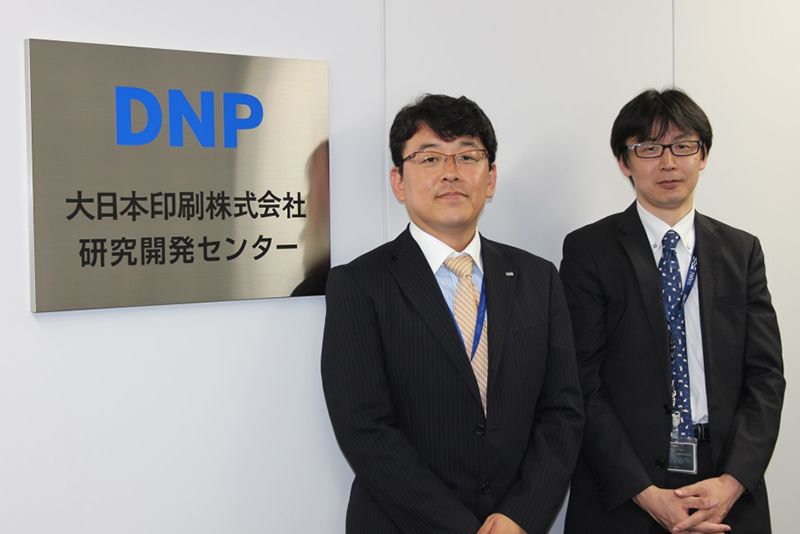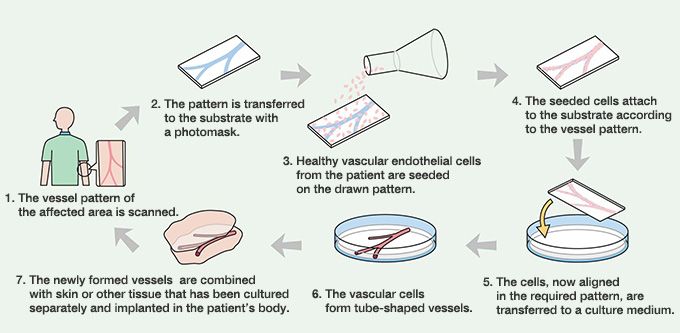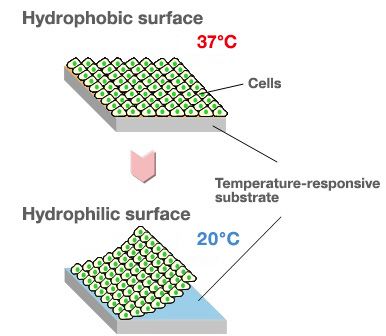
Dai Nippon Printing Branches Out into Regenerative Medicine
Science Technology Society Lifestyle- English
- 日本語
- 简体字
- 繁體字
- Français
- Español
- العربية
- Русский
Bringing Regenerative Medicine Closer
Regenerative medicine refers to the use of artificially cultured cells in the treatment of tissues and cells damaged by disease or accident. In Japan, a law passed in April 2013 to promote work in this relatively new medical field is spurring both public and private efforts. However, only a few technologies, mainly skin and cartilage regeneration (the creation of new tissue by culturing patients’ own cells and transplanting it back into the patient), have reached the level of practical application. Further technical innovations are needed so that greater numbers of people can receive the benefits of regenerative medicine.
 Shimizu Yūji, general manager of Dai Nippon Printing’s Life Science Laboratory (left), and Tsuchiya Katsunori, a laboratory manager.
Shimizu Yūji, general manager of Dai Nippon Printing’s Life Science Laboratory (left), and Tsuchiya Katsunori, a laboratory manager.
As one of Japan’s top printers, Dai Nippon Printing has developed various technologies over the years. The firm is now applying them to establish techniques for the mass production of cells, allowing regenerative medicine to be provided at lower costs.
“Ever since Gutenburg invented the first printing press, printing technology has contributed to the spread of books and led to the development and growth of cultures and religions around the world,” says Shimizu Yūji, the general manager of the Life Science Laboratory in Dai Nippon’s Research and Development Center. “In the same way, we hope to apply printing technology in the field of medicine to enable the stable mass production of cell sheets. This would make regenerative medicine available to many more people.”
Life science projects have a long history at Dai Nippon Printing. The company started manufacturing urine test kits in the 1980s, and since then has branched out into products including aseptically processed packing materials for pharmaceutical products and blood sugar sensor chips. However, none of the firm’s products have strayed too far from its core business categories, paper products and print processes.
Printing Blood Vessels in 3D
The company’s first real steps in the field of medicine came around 2000. In joint research with Tokyo Medical and Dental University in 2004, they established a technique to form capillary patterns by applying the patterning technology used to make printing plates with written characters and photos. This is a technique to artificially create capillaries with very fine calibers of 10 micrometers (one-hundredth of a millimeter) and complex shapes. Human vessel patterns are drawn on a glass substrate, which can then be used to create three-dimensional capillaries that follow the pattern.
This capillary patterning uses photomask technology, which uses ultraviolet irradiation to transfer a precise circuit pattern to a substrate—most often a wafer of silicon in the production of electronic circuit devices. Dai Nippon researchers hit upon the idea of using a compound called polyethylene glycol (PEG) to make capillary patterns. Cells will not adhere to PEG, making it ideal for this application. The pattern formed is a flat sheet, but when this is transferred to a medium of cultured vascular cells, the cells grow around the pattern in tubes, creating three-dimensional vessels. The diagram below shows how this process creates artificial blood vessels for implantation in the patient’s body.
 Creating three-dimensional capillaries in the lab.
Creating three-dimensional capillaries in the lab.
Researchers took artificial blood vessels formed from a human vessel pattern and transplanted them into a mouse with localized anemia. They found that the mouse recovered from the anemia and also had improved motor function. Future clinical application of these vessels in humans may stimulate angiogenesis, the formation of new vessels. Conversely, say the researchers, implanting narrower capillary networks could inhibit vascular function in a part of the body, causing cancer cells to die. And using this technology to culture bone or periodontal cells may make it possible to regenerate deficient skull bone or treat gum disease.
On the basis of these results, Dai Nippon Printing has been collaborating since 2006 with the Life Science Laboratory in the Institute of Advanced Biomedical Engineering and Science, Tokyo Women’s Medical University, where it is fully involved in regenerative medicine research.
Toward Mass Production of Cell Sheets
The printing company is also developing cell sheet culture substrates through joint research with Tokyo Women’s Medical University and CellSeed, a bioventure started by that university, as a mass-production technology that may help to spread regenerative medicine. Cell sheets, made by culturing patients’ own cells in the form of thin films, have been called “living bandages.” These sheets can be transplanted as if attaching a bandage to the affected area. Existing treatments involve injecting individual cells into an affected area, but the cell survival rate is higher with this new method, promising greater therapeutic affect with the same number of cells. Layering cell sheets may also make it possible in the future to make three-dimensional tissues and organs.
In normal cell cultures, cells adhere to the bottom of a culture dish and cannot be collected without the use of special enzymes. In cell sheets, cells are grown until they form a broad film, which then needs to be collected whole. Here, however, using enzymes to remove the growths not only causes the cells to peel off of the dish but also to lose adhesion among themselves, so that the sheet dissolves. To overcome this problem, a team at Tokyo Women’s Medical University has developed a culture technology using a polymer layer whose cell adhesiveness changes with temperature. Simply lowering the temperature is enough to cleanly remove the cell sheet from the dish.
 The surface is hydrophobic at 37°C, but becomes hydrophilic at 20°C, allowing removal of the cells intact in their sheet form.
The surface is hydrophobic at 37°C, but becomes hydrophilic at 20°C, allowing removal of the cells intact in their sheet form.
By applying the nanoprocessing technology used in manufacturing films for liquid crystal displays, Dai Nippon Printing has made this temperature-responsive substrate into a roll shape and successfully mass produced it. Cost and technological challenges remain in the production of cell sheets, but Dai Nippon Printing’s technology promises the further acceleration of practical applications.
“As research progresses, we’ve noticed quite a few points where printing and regenerative medicine overlap,” says Tsuchiya. “When we started this development work we didn’t have a good understanding of the needs and accepted wisdom in medical settings. We were often confused as to what we should do. In medicine safety comes first of all, well before questions like cost. That’s the biggest difference between it and printing. As we worked, though, we explored ways to use the high reproducibility of printing technology to best advantage. Even now we continue to go through repeated processes of trial and error, but have finally reached a stage where doctors and researchers can count on us for certain things we can do as a printing company.”
Dai Nippon Printing’s Life Science Laboratory is not a large research organization. Through collaborations with universities and research organizations, though, a range of different backgrounds provide different perspectives on what is possible. Dai Nippon and its research partners are working to create new paths forward in the field of regenerative medicine.
(Originally written in Japanese by Ushijima Bifue.)
science technology medicine frontier Dai Nippon Printing regenerative cell sheet printing